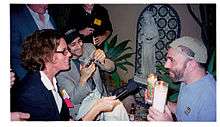Robert Swirsky

Robert Swirsky (born December, 1962, Brooklyn, NY) is a computer scientist, author, and pianist. In the early 1980s, Swirsky was one of the first regular contributors to the nascent computer magazine industry. His articles appeared in magazines ranging from Popular Computing, Kilobaud Microcomputing, and Interface Age to Creative Computing.[1]
Robert Swirsky holds bachelor's and master's degrees in computer science from Hofstra University, and is one of Hofstra's Alumni of Distinction. At Hofstra University, he met VOIP pioneer Jeff Pulver who attended Hofstra as an undergraduate student . After graduating, he worked on projects ranging from aircraft avionics to one of the first all-software digital radio receivers for a VLF submarine application.
In 1989, Swirsky moved to California, and joined Olivetti Advanced Technology's Unix group. He was a frequent speaker at Uniforum, Usenix, and other Unix shows, and hosted parties where he entertained people with song parodies about the Unix computer operating system, some of which were featured in a special Evatone Soundsheet issue of Interface Age magazine.[2] Mr. Swirsky studied music and piano at Hofstra University with professor Morton Estrin.
After Olivetti, Swirsky went to Adobe Systems and was a member of the core PostScript team, and the team that developed the first versions of Photoshop for Microsoft Windows, including Win32s on Microsoft Windows for Workgroups 3.11. His work made him a participant in many industry standards committees, such as TWAIN, and was a frequent speaker and contributor at ACM SIGGRAPH events and meetings. Before leaving Adobe in 1998, he worked with Will Harvey on HTML rendering technology.
The Disney years
In 1998, Robert Swirsky started working for Walt Disney Imagineering R&D as Director, Creative technology,[3] under Bran Ferren, developing electronic games and digital imaging systems. He developed technology to play interactive games synchronized with live television shows, and electronic toys including Disney's Magical Moments Pin. Digital Photography projects included systems to synchronize picture taking with ride vehicles, and active infrared badges to identify picture-takers.
Mr. Swirsky was a major technical contributor to ABC's Enhanced TV,[4] an Emmy Award winning technology that allows television viewers to play along with game shows, sporting events, and answer live polls during talk shows.
Swirsky's interactive media research also involved working with nerdcore rapper Monzy, then an intern at Walt Disney Imagineering, on a variety of cutting edge display technologies, including the display of digital data on a spherical surface.
Mr. Swirsky continues to work as a consultant for the themed entertainment industry, for Disney and other amusement enterprises.[3]
3D photography
Swirsky is known for his work in 3D digital photography. He has developed algorithms for generating full-color anaglyph images from stereo pairs that can be viewed through red/cyan glasses. A popular freeware program, Callipygian 3D is widely used and has been featured on TechTV's The Screen Savers show several times, with Swirsky demonstrating its use.[5] The popularity of anaglyph images from Mars, and in anaglyph movies like Spy Kids 3D introduced new people to the anaglyph technique. Swirsky's software played a major role in letting people create their own anaglyph images.
Production company
In 2003, Swirsky started a production company, Thrill Science, Inc. "Thrill Science"., to produce and distribute short films and related media for the portable media player market. Thrill Science has a 20-acre (81,000 m2) lot adjacent to Walt Disney World in Florida. This property, known as Swampworth, is used as a filming location for productions, and serves as a studio for Swirsky's other projects.
References
External links
- US Patents for Robert Swirsky
- System and method for automating the creation of customized multimedia content
- Method and system for managing the lifecycles of media assets
- Method and system for managing media assets